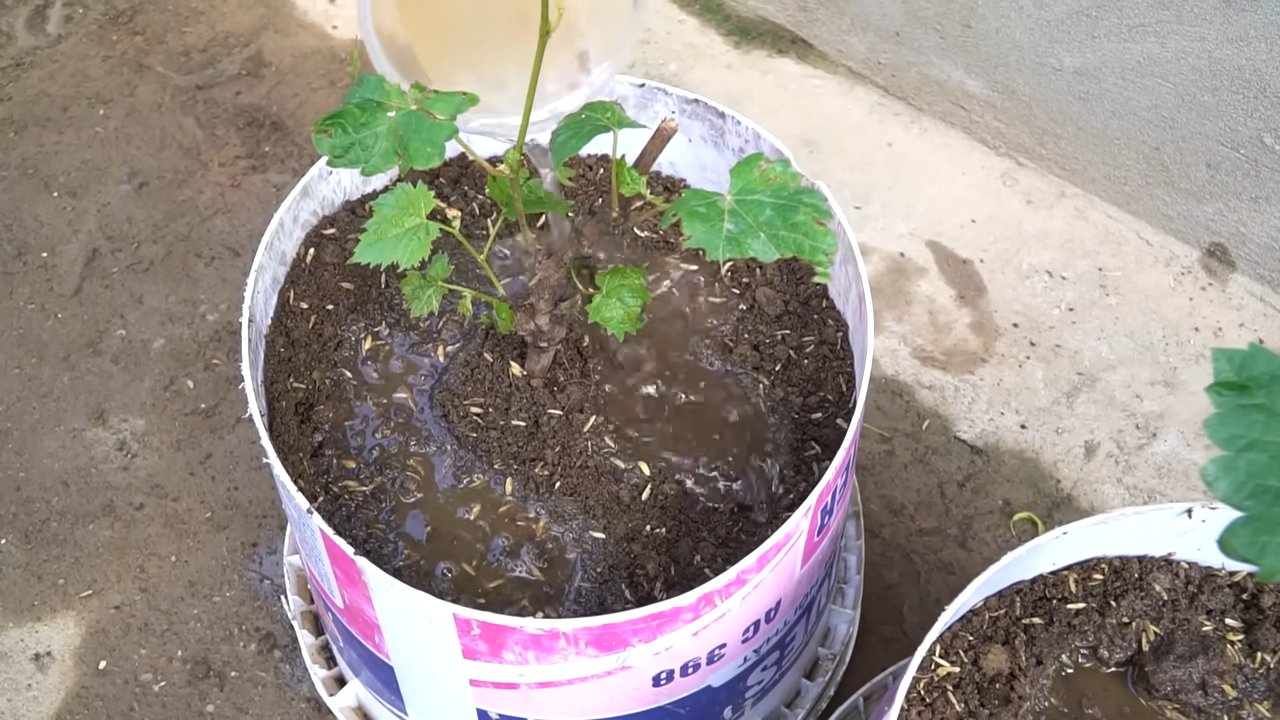Grow grapes at home? Absolutely! Imagine stepping into your backyard and plucking juicy, sun-ripened grapes straight from the vine. Sounds like a dream, right? Well, it doesn’t have to be! This DIY guide is packed with simple yet effective tricks to help you cultivate your own thriving grapevine, even if you’re a complete beginner.
Grape cultivation has a rich history, dating back thousands of years. From ancient civilizations using grapes for wine production to families passing down grape-growing secrets through generations, this fruit has always held a special place in our hearts and cultures. Now, you can become a part of that legacy!
Why should you learn to grow grapes at home? Beyond the sheer joy of harvesting your own delicious fruit, growing grapes can be incredibly rewarding. It’s a fantastic way to connect with nature, learn new skills, and enjoy fresh, healthy produce free from pesticides and harmful chemicals. Plus, think of the bragging rights when you serve homemade grape juice or offer your friends a taste of your homegrown grapes! This article will provide you with the essential knowledge and practical tips you need to succeed, from choosing the right grape variety to protecting your vines from pests and diseases. Let’s get started and turn your backyard into a mini vineyard!

DIY: Your Own Vineyard in the Garden – How to Grow Grapes Yourself!
Hey everyone, have you ever imagined harvesting your own wine or just fresh, juicy grapes directly from the garden? Sounds dreamy, right? I’ll show you how you can turn this dream into reality with a little patience and the right steps. Growing grapes is not as hard as you might think!
The Basics: What You Need for Growing Grapes
Before we get started, let’s make sure we have everything we need. Here is a little checklist:
- Grapevine: The centerpiece! Choose a variety that suits your climate. It’s best to get information from a local nursery.
- Location: A sunny spot is a must! Grapes love the sun.
- Soil: Well-draining soil is important. Grapes do not like waterlogged conditions at all.
- Support/Trellis: Grapes need something to climb on. A trellis, a pergola, or a fence are perfect.
- Garden tools: Spade, shovel, garden shears, possibly a hoe.
- Fertilizer: Special grape fertilizer or compost.
- Patience: Grapes take time to grow and bear fruit.
Choosing the Right Grape Variety: The Key to Your Success
Choosing the right grape variety is crucial. Not every variety thrives in every climate. Here are a few tips:
- Climate Zone: Find out your climate zone. This will help you select varieties that can handle the temperatures and sun exposure in your region.
- Resistance: Look for varieties that are resistant to fungal diseases. This will save you a lot of work and trouble later on.
- Intended Use: Do you want table grapes for snacking or wine grapes for winemaking? This will influence your choice of variety.
- Local Advice: Ask at a nursery or garden center in your area. The experts there can recommend the best varieties for your region.
Step-by-Step Guide: How to Plant Your Grapevine Correctly
Now let’s get down to it! Here is a detailed guide on how to plant your grapevine correctly:
1. Choose the Right Time
The best time to plant grapevines is in the spring (after the last frost) or in the fall. This gives the vines enough time to establish themselves before winter or the summer heat.
2. Prepare the Soil
- Soil analysis: A soil analysis provides information about the pH value and nutrient composition of your soil. A pH value between 6.0 and 7.0 is ideal.
- Soil improvement: Loosen the soil thoroughly and remove weeds and stones. Mix in compost or well-rotted manure to improve soil structure and nutrient content.
- Drainage: Ensure good drainage. If the soil is too clay-heavy, you can mix in sand or gravel.
3. Dig the Planting Hole
- Size: The planting hole should be twice as wide and deep as the root ball of the vine.
- Spacing: The distance between vines depends on the variety and the support system. Find out in advance how much space your variety needs. A rule of thumb is 1.5 to 2 meters (5-7 feet) between vines.
4. Plant the Vine
- Prepare the root ball: Gently loosen the root ball before placing the vine in the planting hole.
- Depth: Plant the vine deep enough so that the graft union (the thickened part of the stem) is about 5-10 cm (2-4 inches) above the soil surface.
- Orientation: Orient the vine so that it grows towards the support system.
5. Fill the Planting Hole and Water
- Filling: Fill the planting hole with the excavated soil and press it down lightly.
- Watering in: Water the vine thoroughly. This helps the soil settle around the roots.
6. Mulching
- Layer of mulch: Apply a layer of mulch (e.g., straw, bark mulch, or grass clippings) around the vine. This retains moisture in the soil, suppresses weeds, and protects the roots from extreme temperatures.
7. Install the Support
- Stability: Secure the vine to the support. Use soft tying materials that will not damage the stem.
Care: How to Ensure Healthy and Productive Grapes
After planting comes care! Here are a few tips on how to keep your grapevines healthy and productive:
1. Watering
- Water regularly: Water the vines regularly, especially during dry periods. Make sure the soil does not dry out.
- Deep watering: It’s better to water less frequently but thoroughly. This encourages the roots to grow deeper into the soil.
2. Fertilizing
- Fertilize regularly: Fertilize the vines regularly with special grape fertilizer or compost.
- Timing: Fertilize in the spring before the vines bud, and again after flowering.
3. Pruning
- Important for yield: Pruning is crucial for the yield and health of the vines.
- Winter pruning: Winter pruning is done in late winter or early spring, before the vines bud. Most of the shoots are removed to shape the vine and promote yield.
- Summer pruning: Summer pruning is done in the summer to shorten the shoots and improve air circulation for the grapes.
4. Diseases and Pests
- Regular checks: Check the vines regularly for diseases and pests.
- Preventive measures: Rely on preventive measures, such as good ventilation of the vines and the use of plant strengtheners.
- Biological pest control: In case of infestation with pests or diseases, use biological pest control methods.
5. Protection from Birds
- Nets: Birds love grapes! Protect your grapes with nets as soon as they ripen.
Harvest Time: The Reward for Your Effort
The time has finally come! The grapes are ripe and can be harvested.
- Signs of ripeness: The grapes are ripe when they have their typical color, come off the stem easily, and taste sweet.
- Harvesting: Cut the grape clusters with sharp scissors.
- Enjoy: Enjoy your home-grown grapes fresh from the vine or process them into juice, jam, or even wine!
Avoiding Common Mistakes: Tips and Tricks for Beginners
Here are a few common mistakes that beginners make when growing grapes, and how you can avoid them:
Neglecting care: Regular watering, fertilizing, and pest control are important.
Wrong choice of variety: Choose a variety that suits your climate.
Wrong location: Grapes need a sunny location.
Poor soil conditions: Ensure well-draining soil.
Incorrect pruning: Pruning is crucial for the yield. Learn exactly how to prune your variety correctly.

Conclusion
So, there you have it! Growing grapes at home might seem daunting at first, but with a little patience, the right knowledge, and our simple DIY trick, you can transform your backyard into a miniature vineyard. Forget those expensive, often bland, supermarket grapes. Imagine the satisfaction of plucking plump, juicy grapes straight from your own vine, knowing you nurtured them from the very beginning. This isn’t just about saving money; it’s about connecting with nature, understanding the growing process, and enjoying the unparalleled flavor of homegrown fruit.
This DIY approach to grape cultivation is a must-try for several reasons. Firstly, it empowers you to control the entire process, from soil composition to pest management, ensuring you’re consuming the healthiest, most natural grapes possible. Secondly, it’s incredibly rewarding. Watching your vine flourish and bear fruit is a deeply satisfying experience. And thirdly, it opens up a world of possibilities for culinary creativity.
Think beyond just eating them fresh. Imagine making your own grape juice, jelly, or even experimenting with homemade wine. The possibilities are endless!
Variations and Suggestions:
* Grape Variety: Don’t be afraid to experiment with different grape varieties. Research which grapes thrive in your climate and choose ones that suit your taste preferences. Consider seedless varieties for easy snacking or wine grapes for a more ambitious project.
* Trellis Design: Get creative with your trellis design. A well-designed trellis not only supports your vine but also adds visual appeal to your garden. Consider using recycled materials or building a custom trellis to match your aesthetic.
* Soil Amendments: Regularly amend your soil with compost and other organic matter to provide your vine with the nutrients it needs to thrive. A healthy soil is the foundation for a healthy vine.
* Pest Control: Keep a close eye on your vine for signs of pests or diseases. Implement preventative measures, such as spraying with organic insecticides or fungicides, to protect your crop.
* Propagation: Once your vine is established, consider propagating new vines from cuttings. This is a great way to expand your vineyard or share your grapes with friends and family.
We’ve provided you with the essential knowledge and a simple DIY trick to get you started. Now, it’s your turn to put it into practice. Don’t be intimidated by the process. Start small, be patient, and learn as you go. The rewards of growing your own grapes are well worth the effort.
We are confident that with our guide, you will be able to successfully grow grapes at home.
We encourage you to try this DIY trick and share your experience with us. Let us know what grape varieties you chose, what challenges you faced, and what successes you celebrated. Your feedback will help us improve our guide and inspire others to embark on their own grape-growing journey. Share your photos and stories on our social media channels using #HomegrownGrapes. We can’t wait to see what you create!
Frequently Asked Questions (FAQ)
1. What is the best time of year to plant grape vines?
The best time to plant grape vines is typically in early spring or late fall, when the vine is dormant. This allows the roots to establish themselves before the growing season begins. Avoid planting during the heat of summer or when the ground is frozen. In warmer climates, late fall planting is often preferred, while in colder climates, early spring planting is recommended to avoid frost damage to newly planted vines.
2. What type of soil is best for growing grapes?
Grapes prefer well-drained soil that is slightly acidic to neutral (pH 6.0-7.0). The soil should be rich in organic matter and have good drainage to prevent root rot. Sandy loam soils are often ideal, as they provide good drainage and aeration. Before planting, it’s a good idea to test your soil and amend it as needed with compost, manure, or other organic materials. Avoid heavy clay soils, as they can retain too much moisture and suffocate the roots.
3. How much sunlight do grape vines need?
Grape vines need at least 6-8 hours of direct sunlight per day to thrive. Sunlight is essential for photosynthesis, which is the process by which plants convert sunlight into energy. Choose a planting location that receives full sun throughout the day. If you live in a particularly hot climate, some afternoon shade may be beneficial to prevent the grapes from scorching.
4. How often should I water my grape vines?
Water your grape vines deeply and regularly, especially during the first year after planting. Water deeply once or twice a week, depending on the weather and soil conditions. Established grape vines are relatively drought-tolerant, but they still need regular watering during dry spells. Avoid overwatering, as this can lead to root rot. A good rule of thumb is to water when the top inch of soil feels dry to the touch.
5. How do I prune my grape vines?
Pruning is essential for maintaining the health and productivity of your grape vines. Prune your vines annually during the dormant season (late winter or early spring). The goal of pruning is to remove dead, damaged, or diseased wood, as well as to shape the vine and encourage fruit production. There are different pruning methods depending on the grape variety and training system. Research the best pruning method for your specific grape variety and follow a pruning guide carefully.
6. What are some common pests and diseases that affect grape vines?
Grape vines are susceptible to a variety of pests and diseases, including aphids, Japanese beetles, grape phylloxera, powdery mildew, and black rot. Monitor your vines regularly for signs of pests or diseases. Implement preventative measures, such as spraying with organic insecticides or fungicides, to protect your crop. Remove any infected leaves or branches promptly to prevent the spread of disease.
7. How long does it take for grape vines to produce fruit?
It typically takes 2-3 years for grape vines to produce a significant crop of fruit. The first year after planting, the vine will focus on establishing its root system. In the second year, you may see some fruit, but it may not be of the best quality. By the third year, your vine should be producing a good crop of grapes. Be patient and continue to care for your vine, and you will be rewarded with delicious, homegrown grapes.
8. Can I grow grapes in containers?
Yes, you can grow grapes in containers, but it requires careful planning and maintenance. Choose a large container (at least 20 gallons) with good drainage. Use a well-draining potting mix and provide a trellis for the vine to climb. Container-grown grapes will need more frequent watering and fertilization than grapes grown in the ground. Choose a grape variety that is well-suited for container growing, such as dwarf or compact varieties.
9. How do I fertilize my grape vines?
Fertilize your grape vines in early spring with a balanced fertilizer that is specifically formulated for fruit trees or vines. Follow the instructions on the fertilizer package carefully. Avoid over-fertilizing, as this can lead to excessive vegetative growth and reduced fruit production. You can also amend your soil with compost or manure to provide your vines with essential nutrients.
10. What is the best way to harvest grapes?
Harvest your grapes when they are fully ripe and have reached their peak flavor. The grapes should be plump, juicy, and easily detach from the vine. Taste a few grapes to determine if they are ready to harvest. Use pruning shears to cut the grape clusters from the vine. Handle the grapes gently to avoid bruising them. Store the harvested grapes in the refrigerator for up to a week.




Leave a Comment